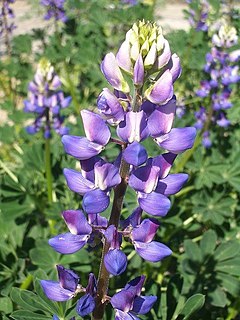
Lupinus succulentus is a species of lupine known by the common names hollowleaf annual lupine, arroyo lupine, and succulent lupine.
Keckiella lemmonii is a species of flowering plant in the plantain family known by the common name Lemmon's keckiella.
Lupinus adsurgens is a species of lupine known by the common name Drew's silky lupine. It is native to the Sierra Nevada and coastal mountain ranges of northern California and southern Oregon, where it grows in forest and other mountain habitat. It is a perennial herb growing 20–60 centimetres (7.9–23.6 in) in height. Each palmate leaf is made up of 6 to 9 leaflets each up to 5 centimetres (2.0 in) long. The herbage is hairy and silvery or gray-green in color. The inflorescence is up to 23 centimetres (9.1 in) long, bearing flowers just over a centimeter long. The flower is pale pink or purple to yellowish with a white or yellow patch on the banner. The fruit is a silky-haired legume pod 2 to 4 centimetres (1.6 in) long containing 3 to 6 seeds.
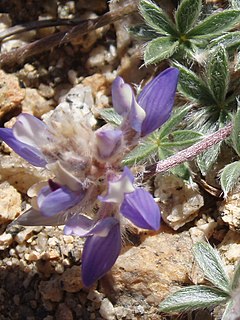
Lupinus breweri is a species of lupine known by the common names Brewer's lupine and matted lupine. It is native to much of California, except for the deserts, and to adjacent sections of Oregon and Nevada, where it is common in some areas, particularly mountain forests. Quite short for a lupine, this is a hairy, mat-forming perennial herb, sometimes becoming like a shrub, with a woody base. The leaves spread out from the stem. Each palmate leaf is made up of 5 to 10 woolly leaflets each up to 2 centimeters (0.79 in) long. The inflorescence is a dense raceme of flowers a few centimeters tall, each flower 4 to 11 millimeters. The flower is blue or purple with a white or yellowish spot on the banner. The fruit is a silky-hairy legume pod 1 or 2 millimeters long.
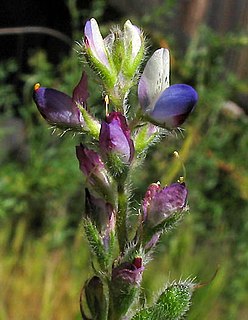
Lupinus concinnus is a species of lupine known by the common name Bajada lupine. It is native to the southwestern United States from California to Texas, and northern Mexico, where it is known from many types of habitat. This is a hairy erect or decumbent annual herb with a stem growing 10 to 30 centimeters long. Each small palmate leaf is made up of 5 to 9 leaflets up to 3 centimeters long and under a centimeter wide, sometimes narrow and linear in shape. The inflorescence is a dense spiral of flowers, with some flowers also appearing in leaf axils lower on the plant. Each flower is 5 to 12 millimeters long and purple, pink, or nearly white in color. The fruit is a hairy legume pod around a centimeter long.

Lupinus dalesiae is a species of lupine known by the common name Quincy lupine. It is endemic to California, where it is known from the northernmost slopes of the Sierra Nevada. This is an erect perennial herb up to half a meter tall. Each palmate leaf is made up of 6 to 9 leaflets each up to 4.5 centimetres (1.8 in) long. The herbage is coated in white hairs. The inflorescence bears whorls of yellow flowers roughly a centimeter long which yield rough-haired legume pods 2 or 3 centimeters in length.

Lupinus duranii is a species of lupine known by the common name Mono Lake lupine. It is endemic to California, where it is known mainly from the eastern slopes of the Sierra Nevada in western Mono County. Its distribution includes Mammoth Mountain and the hills around Mono Lake, and its habitat has gravelly, pumice-rich soils of volcanic origin.
Lupinus elatus is a species of lupine known by the common name tall silky lupine. It is endemic to California, where it is known from the Transverse Ranges above Los Angeles, and possibly also from the southernmost slopes of the Sierra Nevada. Its habitat includes dry areas in the forests of the mountains. This is an erect perennial herb reaching a maximum height near 90 centimeters. Each palmate leaf is made up of 6 to 8 leaflets up to 8 centimeters long. The herbage is coated in silvery silky to woolly hairs. The inflorescence is a long raceme of flowers, each about a centimeter long and arranged in whorls. The flower is purple or blue with a pale yellow patch on its banner. It yields a legume pod 2 or 3 centimeters long. This is a host plant to the Southern California native butterfly subspecies known as the San Gabriel Mountains Arrowhead Blue.
Lupinus lapidicola is a rare species of lupine known by the common name Mt. Eddy lupine. It is endemic to California, where it is known from only a few locations in the northernmost mountain ranges, including Mount Eddy in the Klamath Mountains. It is a small, compact perennial herb forming mats no more than 10 centimetres (3.9 in) tall. Each palmate leaf is divided into 6 to 8 leaflets up to 2 centimetres (0.79 in) long. The herbage is coated in silvery silky hairs. The inflorescence is a small bundle of flower whorls, each flower about a centimeter long and purple in color with a yellowish patch on its banner.
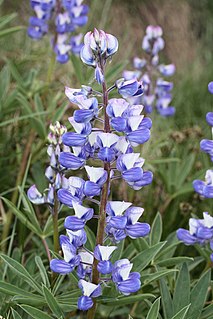
Lupinus latifolius is a species of lupine known by the common name broadleaf lupine. It is native to western North America from British Columbia to Baja California to New Mexico, where it is common and can be found in several types of habitat. There are several subtaxa, described as subspecies or varieties, some common and some rare. They vary in morphology. In general this plant is an erect perennial herb. It grows 30 centimeters to over two meters in height, in texture hairy to nearly hairless. Each palmate leaf is made up of several leaflets, those on larger plants up to 10 centimeters long. The inflorescence bears many flowers, sometimes in whorls. Each flower is one to two centimeters in length, purple to blue to white in color, the spot on its banner yellowish, pinkish, or white.
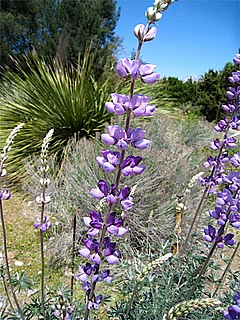
Lupinus longifolius is a species of lupine known by the common name longleaf bush lupine.
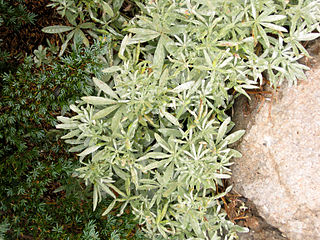
Lupinus obtusilobus is a species of lupine known by the common name bluntlobe lupine. It is native to high mountains of northern California, including the North Coast Ranges, the Klamath Mountains, and the northernmost Sierra Nevada. It grows in various types of mountain habitat, sometimes carpeting meadows with its purple blooms in the spring. It is a perennial herb growing erect or decumbent along the ground, its stem 15–30 centimetres (5.9–11.8 in) long. Each palmate leaf is made up of 6 to 7 leaflets up to 5 centimetres (2.0 in) long. The herbage is coated in silvery silky hairs. The inflorescence is a small raceme with a few whorls of flowers each just over a centimeter long. The flower is blue to purple with a yellowish patch on its banner. The fruit is a silky-haired legume pod up to 4 centimetres (1.6 in) long.
Lupinus onustus is a species of lupine known by the common name Plumas lupine. It is native to the high mountains of northern California, from the northern Sierra Nevada to the Klamath Mountains where its distribution extends just into Oregon. It grows in mountain forest habitat, sometimes on serpentine soils. It is a perennial herb with a short, decumbent stem and erect inflorescence reaching heights between 20 and 30 centimeters. Each palmate leaf is made up of 5 to 9 leaflets up to 5 centimeters long. The stout inflorescence bears many unwhorled flowers each around a centimeter long. The flower is partly or entirely purple in color.
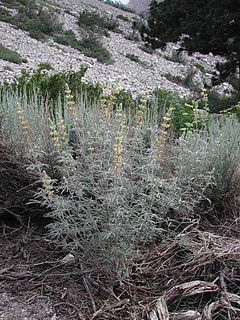
Lupinus padre-crowleyi is a rare species of lupine known by the common names DeDecker's lupine and Father Crowley's lupine. It is endemic to California, where it is known only from the eastern slopes of the Sierra Nevada and the high plateau below along the western border of Inyo County. It grows in the granite soils of the mountain forests and scrub. It has been noted at fewer than 20 locations. This is a perennial herb growing an erect inflorescence from a mat of silvery, woolly-haired herbage, reaching maximum heights over half a meter. Each palmate leaf is made up of 6 to 9 leaflets up to 7.5 centimeters long. The inflorescence is a raceme of whorled flowers each just over a centimeter long. The flower is cream to pale brownish yellow in color. The fruit is a silky-haired legume pod containing black-mottled white seeds.
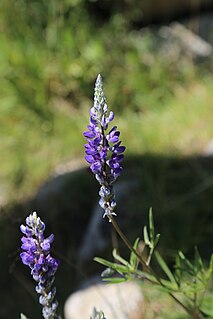
Lupinus pratensis is a species of lupine known by the common name Inyo meadow lupine. It is endemic to California, where it grows in the central Sierra Nevada and adjacent plateau and valleys to the east. It grows in relatively moist habitat, such as streambanks and spring meadows. This is an erect perennial herb growing 30–70 centimetres (12–28 in) tall. Each palmate leaf is made up of 5 to 10 narrow leaflets sometimes exceeding 10 centimetres (3.9 in) long. The leaves are borne on long petioles which can reach 25 centimetres (9.8 in) in length. The herbage is green and coated in thin hairs. The inflorescence is a dense raceme of many flowers each around a centimeter long. The flower is dark blue or purple with a reddish or orange patch on its banner. The fruit is a hairy legume pod around 2 centimetres (0.79 in) long.
Lupinus shockleyi is a species of lupine known by the common name purple desert lupine. It is native to the Mojave and Sonoran Deserts, where it grows in open desert habitat. It is an annual herb growing up to 30 centimeters tall. Each palmate leaf is made up of 8 to 10 leaflets measuring 1 to 3 centimeters in length. The inflorescence is a small spiral of flowers. Each flower is about half a centimeter long and deep purple-blue in color with a yellowish patch on its banner. The fruit is an oval legume pod coated in thick, inflated hairs.

Lupinus spectabilis is a species of lupine known by the common name shaggyhair lupine. It is endemic to a section of the central Sierra Nevada foothills in Mariposa and Tuolumne Counties, where it is a member of the serpentine soils flora.

Lupinus stiversii is a species of lupine known by the common names harlequin annual lupine and harlequin lupine. The plant was named for Army physician Dr. Charles Austin Stivers, who first collected it in 1862 near Yosemite.
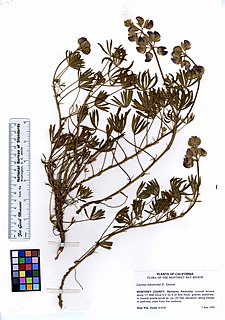
Lupinus tidestromii is a rare species of lupine known by the common names clover lupine and Tideström's lupine. It is endemic to the coastline of California just to the north and south of the Golden Gate in Sonoma, Marin, and Monterey Counties. It is a plant of the sand dunes at separate beach locations in these counties. A very limited amount of this plant's habitat remains; it is a federally listed endangered species. Construction of golf courses on the Monterey Peninsula caused the extirpation of two known occurrences, and boardwalks were built at Asilomar State Beach to prevent trampling of the delicate dune habitat there.

Lupinus truncatus is a species of lupine known by the common name collared annual lupine.













